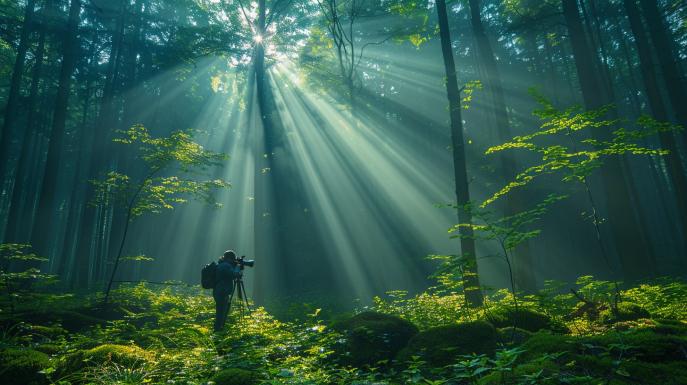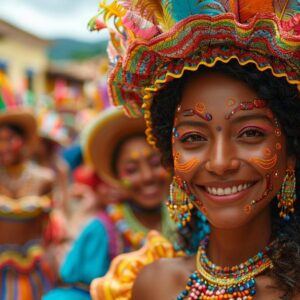Have you ever come across ordinary scenes that, from a new angle, reveal an unexpected magnificence? In the universe of artistic photography, the ordinary is transformed into a visual spectacle, and beauty waits to be revealed around it. “Artistic Photography: guide to techniques and themes” is the map for this transformative journey. Here, we will explore fundamental methods and photographic compositions that metamorphose the trivial into the extraordinary. Do you want to get started in this art or improve your creative outlook? We'll reveal how everyday settings can become the stage for your most impressive photographic works. Navigate with us through this mosaic of light, shadow, color and emotion!
How to capture beauty in ordinary settings through artistic photography?
What are the basic techniques to get started in artistic photography? Basic techniques include an understanding of composition, play of light and shadow, and a unique perspective that can transform ordinary scenes into captivating images. Essential to the composition are the Rule of Thirds, guiding lines and framing, directing the viewer's attention intentionally.
Photographic composition strongly influences the aesthetics of images. It is the careful arrangement of visual elements within the frame that guides the reading of the image and directly affects its emotional impact on the viewer. Through it, a simple walk through the park can become an exploration of geometric patterns, contrasts of light and details that would previously go unnoticed.
And how to transform ordinary scenarios into extraordinary works of photographic art? Look around you and view everyday life with a fresh eye, looking for beauty in the details: the symmetry of windows in a building, the play between light and shadow on a busy sidewalk, or the contrast of vibrant colors in a local market. The ability to see beyond the obvious and capture a moment that reveals something about the scene or your own perception of the world is what characterizes artistic photography.
Remember, lighting is critical, with the so-called “golden hour” providing perfect conditions to portray the warmth and softness of the sun's last rays, creating dramatic and inviting atmospheres. Subject selection is crucial and varies greatly – it could be nature, urban scenes, or everyday moments presented in a new or provocative way.
Color or black and white photography adds distinct qualities – colors convey emotions and contrasts, while black and white highlights composition, texture and form. With digital post-processing tools, adjustments to contrast and saturation can intensify the artistic message, but always with caution to maintain the authenticity of the image.
Regardless of the equipment, artistic photography relies much more on the photographer's creativity than on the cost of his equipment. An artistic perspective, when aligned with technique and ethics, tends to result in images of great personal satisfaction and emotional impact. And, by participating in online communities and platforms, receiving constructive criticism, the development and inspiration of the photographer-artist are immeasurably enriched.
How can I use light to highlight details and create emotions in my photographs?
Lighting in photography has a transcendental role, after all, it is what models shapes, determines texture and color, and can evoke or dissipate feelings. As such, understanding the influence of natural light on photos is a foundation for artistic photography. With this in mind, what would be the best practices for manipulating lighting in different environments? The answer involves knowing the direction and quality of the light, whether it is diffuse — ideal for softening shadows and highlighting details — or direct — to create a more dramatic effect and highlight textures.
In practice, the best practices are limited to observing and using natural lighting conditions to enhance or create contrast in the desired elements. For example, backlit photography can highlight contours, and side light can exacerbate textures.
But, Why is the “golden hour” so valued in artistic photography? The “golden hour” refers to the first and last hours of daylight, when the sun is low on the horizon, producing a soft, diffused golden light. It is such a cherished moment because the quality of natural light is exceptionally soft, long and warm, giving the images a dreamlike and flattering atmosphere. This moment of the day highlights colors, adorns the sky with dynamic tones and generates elongated shadows that can be used to guide the viewer's eye through the composition.
Capturing light in photography is not just about capturing, but about feeling the environment and translating these visual impressions into the language of emotions. The golden hour is just one example of how lighting in photography it can be handled to enhance details and conceive feelings, moving from the tangible to the ethereal. In doing so, a photographer not only captures the image, but the essence of that singular moment, preserving it beyond the now.
What themes should I choose to portray beauty and expressiveness through artistic photography?
Choosing themes in artistic photography is crucial to capture beauty and expressiveness in your images. But how do you identify themes that resonate with your personal photographic style? Start by noticing what naturally attracts your attention and passions—whether it's the immensity of a landscape, the complexity of a human expression, or the simplicity of an urban composition.
In artistic landscape photography, the impact is enormous. The magnitude of a mountain reflected in a serene lake or the texture of desert sand at sunset can evoke deep emotions in the viewer. Art portraits, on the other hand, capture the human essence. They reflect the depth of emotions, untold stories and intimate moments that just a look or a smile can reveal.
Value the ability to see the extraordinary in the ordinary, breathing new life into everyday scenes through your lens. Picture the dance of light on a dimly lit building, or the hidden symmetry in the stairs of a busy street. When choosing a theme, consider that each choice is an extension of your artistic self. What do these themes say about you and the world around you? How can your photos change someone's perception of a place or person?
Remember that the authenticity of emotions and cultural context are as important as aesthetics. In every subject you choose, from stunning macro photography to a vast panorama, your goal is to not only capture what is visually appealing, but also what is emotionally resonant.
Aim for the intimate connection with what you photograph. The themes that spark interest and curiosity in you are the ones that will inspire your best works. Be imbued with a mission: When experimenting with natural landscapes or emotional portraits, seek not just the beauty, but the story each image tells.
Thus, artistic photography becomes a dialogue between the photographer, the subject, and the viewer. This dialogue is what brings true beauty—beauty that is perceived not only with the eyes, but also with the soul.
How can colors and black and white be used to convey different sensations in photographs?
Have you ever wondered how colors and their absence can profoundly affect the perception of an image? In artistic photography, the use of colors in art photography It is a powerful tool for communicating feelings and creating atmospheres. Vibrant colors, for example, can evoke joy and excitement, while softer tones can convey calm and serenity.
A color psychology in photography is a fascinating field that explores exactly that: how they affect the mood of images. Warm colors, like red and yellow, can create a feeling of warmth and passion, while cool colors, like blue and green, tend to bring a more calming and reflective sensitivity.
On the other hand, the black and white photography is renowned for its ability to capture the essence of emotion without the “noise” of colors. By exploring contrast and simplicity, black and white photos highlight textures and contours, allowing the composition and visual narrative to speak louder.
Eliminating color can intensify the impact of shapes and lines, leading the viewer to a deeper appreciation of the play between light and shadow, creating an emotional connection that often transcends color photography. The absence of color can reveal the timeless beauty of a portrait or the dramatic interplay of clouds in a stormy sky, capturing the intensity of human emotions or the majesty of nature.
Whether life in color or the eloquent simplicity of black and white, each choice is an artistic statement that shapes the viewer's visual experience. So on your next photography adventure, consider not only what you're seeing, but also what you feel. How can color, or its absence, better capture the essence of what is before you?
How can image editing improve my photos artistically without compromising their authenticity?
When we talk about image editing, many may think of drastic changes that transform the original photo. But is it possible to use editing to enhance the beauty of the image without losing its essence? The answer is yes. Editing can artistically improve your photos by adjusting elements such as contrast, exposure and saturation in subtle ways, maintaining visual harmony and respecting the original photographic composition.
In the quest to create a stronger visual impact, it is essential to edit in moderation. The perfect balance lies in valuing the attributes already present in the image, such as light and colors, without the editing becoming the focus of attention to the detriment of what was captured by the lens. This requires care and a critical eye. For example, simply correcting exposure can restore lost detail in shadows or highlight nuances in highlights that bring a photo to life. Adjusting saturation can also emphasize certain tones that stand out in the photo without, however, saturating them to the point of appearing artificial.
Visual harmony in photographic compositions can be preserved and even improved with adjustments to elements such as white balance, which aligns image colors closer to what the human eye naturally perceives. Thus, a late afternoon photograph can display warm tones that evoke the feeling of serenity of the moment, but without exaggerations that could distort reality.
Using editing tools to crop or recompose the image can also reinforce the message the photographer wants to convey, directing attention to key points through careful application of composition rules, such as the Rule of Thirds.
Authenticity, then, is preserved by respecting the elements that make up the moment captured, maintaining the integrity of the scene and the artist's original intention. The editing is not to camouflage, but to further enhance the beauty that already exists.
Artistic Photography: guide to techniques and themes
Artistic photography is a kitchen full of techniques and themes ready to be explored. And what are the basic techniques to get started in artistic photography? The foundation begins with understanding elements such as composition, lighting, and choosing the theme. The ability to see beyond the obvious is what transforms common scenarios into true works of art.
Speaking of photographic composition, one of the first concepts we should embrace is the Rule of Thirds, which helps us position the elements of the photo in a balanced and attractive way. Guidelines and the art of framing are also essential techniques that guide the viewer's attention to points of interest in the image. But how does composition influence the aesthetics of images in everyday life? Simply put, compose the visual music that our photography will play. Well-placed elements create visual harmony and guide the eye in a dance through the captured scene.
The choice of subjects in artistic photography is another crucial aspect and can range from the immensity of a landscape to the delicacy of a portrait. The beauty is in the way we present these themes, with the aim of capturing beauty in unexpected or provocative ways. Artistic landscape photography invites the viewer to see beyond the obvious, while artful portraits can reveal the soul behind the subject. But how can I transform ordinary scenes into extraordinary photographic works of art? This requires a keen eye for detail, recognizing patterns, textures and moments that would often go unnoticed.
In the sea of possibilities that is artistic photography, from the choice of equipment to ethical considerations, the true magic lies in your unique vision. And even though art is subjective, it is your personal expression that brings the authenticity that we seek so much in each click. Art photography captures not only the beauty around you, but also the essence of who you are as an artist.
In this post, we explore the universe of artistic photography, covering essential techniques and the importance of composition to transform everyday scenes into extraordinary images. We discuss the role of light in creating atmospheres and emotions, and dive into selecting themes that converge with your style and express beauty and emotion. Furthermore, we highlight the impactful use of colors and the eloquence of black and white to communicate varied sensations, ending with tips for editing that improves the art without losing authenticity.
Understanding these elements not only improves your photographs, but also broadens your perception and appreciation of the world around you. Artistic photography is a window to the soul, a permanent invitation to see beyond the obvious and capture the beauty that often goes unnoticed. It's testimony that, with the right vision, the ordinary can become memorable.
Frequently Asked Questions (FAQ)
What are the fundamental techniques for beginners in artistic photography?
Elementary techniques for getting started in fine art photography include understanding composition, effective use of light and shadow, and the ability to capture a unique perspective. Elements such as the Rule of Thirds, guiding lines and framing are vital to intentionally direct the viewer's gaze and transform ordinary scenes into extraordinary images.
How can lighting enhance the beauty in my photographs?
Lighting can enhance details, texture and color, as well as evoke feelings. Natural light varies in quality and direction, and knowing how to manipulate it is essential. The “golden hour” is particularly valued for providing a soft, diffused golden light that enhances colors and creates dreamlike, flattering atmospheres.
How can I choose subjects that highlight beauty and expressiveness in artistic photography?
To portray beauty and expressiveness, choose subjects that echo your personal photographic style and that naturally attract your attention. Whether it's a grand landscape or the symmetry in an ordinary urban scene, seek to see the extraordinary in the ordinary and capture the essence of the moment, telling stories through your lens.
How can colors or the choice of black and white influence the sensations conveyed by photos?
Colors can convey different emotions – vibrant colors evoke joy, while soft hues communicate calm. Color psychology helps shape the mood of images. Black and white photography, on the other hand, highlights textures and shapes, allowing composition and narrative to be more prominent.
Can image editing artistically enhance my photos without compromising authenticity?
Yes, editing can artistically enhance photos without compromising their authenticity. Subtle adjustments to contrast, exposure, and saturation can enhance visual elements without overwhelming the image. Maintaining balance in editing is crucial to enhance natural attributes and respect the original composition. Authenticity is preserved in the integrity of the scene and the artist's intention.







